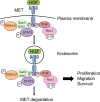The role of MET in chemotherapy resistance
- PMID: 33526881
- PMCID: PMC7979538
- DOI: 10.1038/s41388-020-01577-5
The role of MET in chemotherapy resistance
Abstract
Chemotherapy remains the mainstay of treatment in the majority of solid and haematological malignancies. Resistance to cytotoxic chemotherapy is a major clinical problem and substantial research is ongoing into potential methods of overcoming this resistance. One major target, the receptor tyrosine kinase MET, has generated increasing interest with multiple clinical trials in progress. Overexpression of MET is frequently observed in a range of different cancers and is associated with poor prognosis. Studies have shown that MET promotes resistance to targeted therapies, including those targeting EGFR, BRAF and MEK. More recently, several reports suggest that MET also contributes to cytotoxic chemotherapy resistance. Here we review the preclinical evidence of MET's role in chemotherapy resistance, the mechanisms by which this resistance is mediated and the translational relevance of MET inhibitor therapy for patients with chemotherapy resistant disease.
Conflict of interest statement
The authors declare that they have no conflict of interest.
Figures


References
-
- Ménard L, Parker PJ, Kermorgant S. Receptor tyrosine kinase c-Met controls the cytoskeleton from different endosomes via different pathways. Nat Commun. 2014;5. 10.1038/ncomms4907. - PubMed
Publication types
MeSH terms
Substances
Grants and funding
LinkOut - more resources
Full Text Sources
Other Literature Sources
Medical
Research Materials
Miscellaneous

